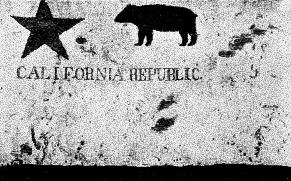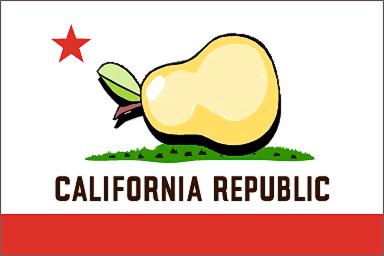The states of Texas and California have much in common historically: Admitted to the Union within five years of each other, both were much larger in area than any existing state (California was over twice as big, and Texas more than three times as big, as the then-largest state, Missouri, and they remained the two biggest states until the admission of Alaska more than a century later), both were wrested from Mexico through uprisings led by American-born revolutionaries, both declared themselves republics before joining the United States, and both later adopted state flags bearing single stars to symbolize their statuses as previously independent entities. One curious historical oddity distinguishes California from Texas, however: the design used for California’s state flag was the result of a rather large (and embarrassing) mistake.
Most Americans are familiar with the basics of the Texas Revolution of 1835-36, particularly the heroic stand staged by the defenders of the Alamo in San Antonio, but the story of the 1846 revolt in California is far less well known. It began on the morning of 14 June 1846 when a small but heavily-armed group of thirty-three American-born settlers — led by Captain Jebediah Bartlett and his two lieutenants, Albert Bosc and Emmanuel d'Anjou — approached the home of General Mariano G. Vallejo, the Mexican comandante-general of California, pounded on the door and demanded he surrender the Sonoma Plaza fortress to them. Vallejo, an advocate of the American annexation of California despite his nationality, told the intruders he was sympathetic to their cause; nonetheless, they placed him under arrest and shipped him off to be held at Sutter's Fort.
The rebels quickly decided to raise a new flag over Sonoma Plaza to announce their victory, resulting in hurried discussion about the composition of the banner. Most agreed it should feature something physically symbolic of California (and distinctly non-Mexican), but they could not reach a consensus on what that symbol should be. Finally Captain Bartlett, an agricultural magnate with large holdings in the Sacramento River area (and an amateur horticulturist who developed the
Bartlett pear), broke the deadlock by "suggesting" (none too gently) that the banner include a symbol reflective of the lush agricultural regions of northern California and the rich, 400-mile long Central Valley area.
Acquiescing to the desires of their leader, the group quickly decided to honor both him and California agriculture by opting for a pear as the primary motif of their new flag.
The group hurriedly assembled a rough prototype for their banner by borrowing a rectangular piece of light brown muslin and a four-inch strip torn from a red petticoat, sewing the red stripe (reminiscent of the ones found on the American national flag) onto the muslin, drawing a star in the upper left-hand corner to symbolize their independence (and, some claim, to express the rebels' solidarity with troops currently engaged in a war with Mexico precipitated by a dispute over the boundary of the recently-annexed state of Texas), and writing the words CALIFORNIA REPUBLIC in black to the right of the star. This nascent flag was then dispatched by messenger to the nearby home of William L. Todd (nephew of Mary Todd Lincoln, the wife of future president Abraham Lincoln) along with instructions for him to paint an image of a pear in the large empty portion of the banner and send the flag back with the messenger. But Todd misread the note (whether bad handwriting, poor spelling, or smeared ink was to blame remains a subject of dispute) and instead painted a crude bear onto the muslin, producing something like the following:
The rebels hoisted their hastily-prepared pennant over Sonoma Plaza despite the error, intending to remake the flag at the first opportunity. The issue become moot within a month, however, when an American squadron under Commodore John D. Sloat captured California’s then-capital, Monterey, and proclaimed California to be American territory, bringing an end to the short-lived California Republic. The territory was formally ceded to the United States by Mexico at the conclusion of the Mexican-American War in 1848, and California was admitted to the Union as the 31st state in 1850.
When California adopted an official state flag in 1911, they hearkened back to the days of that brief republic of 1846 and chose a modernized rendition of the (mistaken) bear flag design. Then, as now, few remembered that the bear flag was the product of a mistake or realized that a historically accurate California flag should look something more like this:
When the creators of television's political drama The West Wing (filmed in California, naturally) created their series in 1999, they gave a nod to this chapter of the Golden State's history through the in-joke of naming their fictional president "Jed Bartlet."


